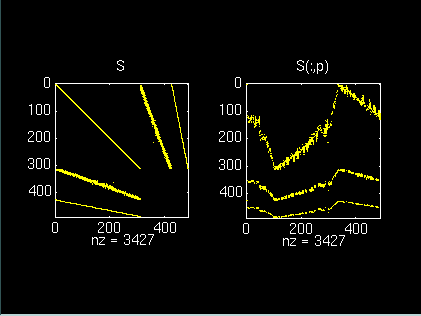load('abb313.mat')
S = spaugment(abb313);
p = colmmd(S);
spy(S)
spy(S(:,p))

p = colmmd(S)
p = colmmd(S) returns the column minimum degree ordering of S. For an asymmetric matrix S, this is a column permutation p such that S(:,p) tends to have sparser LU factors than S.
The colmmd ordering is automatically used by \ and / for the solution of nonsymmetric and symmetric indefinite sparse linear systems.
Some options and parameters associated with heuristics in the algorithm can be changed with spparms.
A'*A, but does not actually form A'*A.
Each stage of the algorithm chooses a vertex in the graph of A'*A of lowest degree (that is, a column of A having nonzero elements in common with the fewest other columns), eliminates that vertex, and updates the remainder of the graph by adding fill (that is, merging rows). If the input matrix S is of size m-by-n, the columns are all eliminated and the permutation is complete after n stages. To speed up the process, several heuristics are used to carry out multiple stages simultaneously.
spaugment), which is square and of order 489. The spy plot shows that the nonzeros in the original matrix are concentrated in two stripes, which are reflected and supplemented with a scaled identity in the augmented matrix. The colmmd ordering scrambles this structure.
Comparing the spy plot of the LU factorization of the original matrix with that of the reordered matrix shows that minimum degree reduces the time and storage requirements by better than a factor of 2.6. The nonzero counts are 18813 and 7223, respectively.load('abb313.mat')S = spaugment(abb313);p = colmmd(S);spy(S)spy(S(:,p))
spy(lu(S))spy(lu(S(:,p)))
\,colperm,lu,spparms,symmmd,symrcm
[2] John R. Gilbert, Cleve Moler, and Robert Schreiber, "Sparse Matrices in MATLAB: Design and Implementation," SIAM Journal on Matrix Analysis and Applications 13, pp. 333-356, 1992.
(c) Copyright 1994 by The MathWorks, Inc.